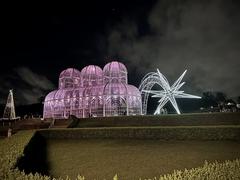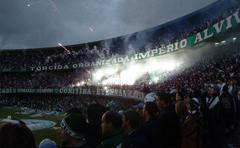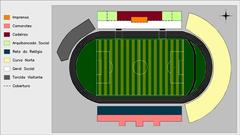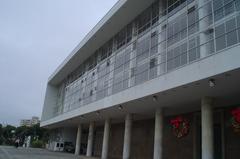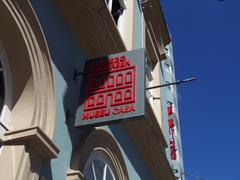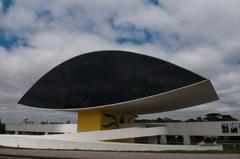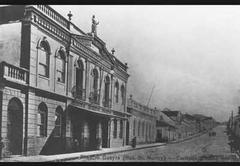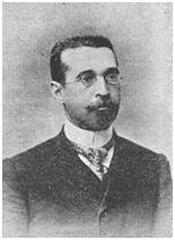
Cathedral Basilica Minor of Our Lady of Light, Curitiba: Visiting Hours, Tickets, and Historical Significance
Date: 04/07/2025
Introduction
The Cathedral Basilica Minor of Our Lady of Light (Catedral Basílica Menor Nossa Senhora da Luz dos Pinhais) is a monumental symbol of Curitiba’s historical and spiritual legacy. Located at the heart of the city in Praça Tiradentes, this neo-Gothic and neo-Romanesque marvel stands as both the seat of the Archdiocese of Curitiba and a vibrant center for religious, cultural, and civic life. Since the original chapel’s foundation in 1668, the site has witnessed over three centuries of transformation, culminating in the grand cathedral completed in 1893. Today, it welcomes pilgrims, tourists, and history enthusiasts alike to experience its architectural grandeur, artistic treasures, and living traditions (Paróquia Catedral, Curitiba City Hall, Vatican News).
Table of Contents
- Early Foundations and Colonial Beginnings
- Construction of the Present Cathedral
- Architectural Evolution and Artistic Heritage
- Religious and Civic Significance
- Role in Urban Development and Identity
- Visitor Information: Visiting Hours, Tickets, and Tours
- Preservation and Contemporary Relevance
- Notable Historical Events
- Legacy and Influence
- Frequently Asked Questions (FAQ)
- Practical Tips for Visitors
- Nearby Attractions
- Contact Information
- Summary and Recommendations
- References
Early Foundations and Colonial Beginnings
The cathedral’s origins trace back to 1668, when settlers established a modest chapel dedicated to Our Lady of Light, serving as both a spiritual and community center for the village that would become Curitiba. As the settlement grew—achieving official town status in 1693—the original chapel was progressively expanded and renovated, mirroring the increasing influence of Catholicism in the region (Curitiba City Hall).
Construction of the Present Cathedral
By the late 19th century, Curitiba’s growth and modernization called for a grander religious edifice. The previous parish church was demolished in 1875, making way for the current cathedral; its cornerstone was laid in 1876 under the direction of French architect Alphonse de Plas. Drawing on European neo-Gothic and neo-Romanesque influences, construction spanned nearly two decades, culminating in the cathedral’s inauguration in 1893. The resulting structure features an imposing façade, twin towers, and intricately detailed stained-glass windows (Paróquia Catedral).
Architectural Evolution and Artistic Heritage
The cathedral exemplifies a harmonious blend of neo-Gothic and neo-Romanesque styles. Its 60-meter-long nave, 54-meter-high towers, and Latin cross floor plan define the city’s skyline (Curitiba Turismo). Inside, visitors encounter elaborate frescoes, statuary, a marble altar with a revered statue of Our Lady of Light, and stained-glass windows imported from France and Germany. The pipe organ, installed in 1929, is a centerpiece for liturgical music and cultural events. Restoration efforts in the late 20th and early 21st centuries have preserved these artistic features for future generations (Gazeta do Povo).
Religious and Civic Significance
Since its consecration, the cathedral has been the spiritual heart of Curitiba, serving as the seat of the Archdiocese and the site of major liturgical celebrations—including the annual feast of Our Lady of Light on February 2nd and September 8th. Elevated to minor basilica status by Pope Pius XII in 1947, it hosts ordinations, confirmations, and civic events, anchoring religious and community life in the city (Vatican News).
Role in Urban Development and Identity
Strategically positioned in Praça Tiradentes, the cathedral has shaped the city’s urban fabric. Its presence influenced the orientation of streets and the development of adjacent civic buildings. The cathedral’s silhouette is a recurring motif in municipal symbols and local art, reflecting its enduring role in Curitiba’s collective memory (Curitiba City Hall).
Visitor Information: Visiting Hours, Tickets, and Tours
-
Visiting Hours:
- Monday to Friday: 7:00 AM – 6:00 PM
- Saturday: 7:00 AM – 5:00 PM
- Sunday: 7:00 AM – 7:00 PM
(Hours may vary during religious holidays and special events.)
-
Admission:
Entry is free; donations are welcome to support preservation and social outreach. -
Guided Tours:
Offered in multiple languages upon request or during special occasions. Booking in advance is advised, especially for groups. -
Accessibility:
Wheelchair accessible, with ramps and designated seating. -
Photography:
Permitted except during services; flash discouraged. -
Events:
The cathedral regularly hosts concerts, exhibitions, and religious festivals. Check the official website for current schedules.
Preservation and Contemporary Relevance
Declared a heritage site in 1977, the cathedral benefits from ongoing restoration projects that protect its stained glass, stonework, and artworks (IPHAN). Beyond religious functions, it serves as a venue for cultural events, educational programs, and social initiatives—reinforcing its role as a living monument and community hub.
Notable Historical Events
The cathedral has been present at pivotal moments in Curitiba’s history—from early 20th-century political upheavals to the centennial celebrations in 1993 and the visit of Pope John Paul II in 1980. Its bells have marked the city’s joys and sorrows, and its steps have welcomed countless civic gatherings (Gazeta do Povo).
Legacy and Influence
The Cathedral Basilica Minor of Our Lady of Light is a symbol of Curitiba’s resilience and cultural diversity. Its artistic and architectural splendor, combined with ongoing community engagement, continues to inspire residents and visitors. The cathedral’s story is intrinsically linked to the city’s past, present, and future (Curitiba Turismo).
Frequently Asked Questions (FAQ)
Q: What are the cathedral’s visiting hours?
A: Monday to Friday: 7:00 AM – 6:00 PM; Saturday: 7:00 AM – 5:00 PM; Sunday: 7:00 AM – 7:00 PM (subject to change).
Q: Is there an entrance fee?
A: No, entry is free. Donations are appreciated.
Q: Are guided tours available?
A: Yes, in multiple languages. Book in advance or inquire at the visitor center.
Q: Is the cathedral wheelchair accessible?
A: Yes, with ramps and accessible seating.
Q: Can I take photos inside?
A: Yes, except during services. Please do not use flash.
Q: When is the best time to visit?
A: Early mornings and weekdays for fewer crowds; major festivals for cultural immersion.
Practical Tips for Visitors
- Dress Modestly: Especially if attending services.
- Plan Ahead: Check the official website for updates on hours and events.
- Language: Most signage is in Portuguese; translation apps or local guides may help.
- Safety: Praça Tiradentes is safe during the day, but remain vigilant with valuables.
- Accessibility: Public transport, parking, and ramps available.
Nearby Attractions
- Largo da Ordem: Historic district with markets and colonial architecture.
- Museu Paranaense: Regional history museum.
- Rua XV de Novembro: Pedestrian street with shops and cafés.
- Palácio Avenida: Iconic building, especially festive during Christmas.
Contact Information
- Address: Praça Tiradentes, s/n - Centro, Curitiba - PR, 80020-100, Brazil
- Phone: +55 (41) 3324-5136
- Official Website: Arquidiocese de Curitiba
Summary and Recommendations
The Cathedral Basilica Minor of Our Lady of Light is an enduring emblem of Curitiba’s architectural beauty, spiritual devotion, and communal identity. Its neo-Gothic façade, twin towers, and brilliant stained-glass windows are matched by a rich program of religious and cultural events that welcome all. Free admission, accessible facilities, and the availability of guided tours make this a must-visit for any traveler to Curitiba. For the best experience, consult official resources, respect the sacred space, and consider enhancing your visit with digital guides like the Audiala app.
References
- Cathedral Basilica Minor of Our Lady of Light in Curitiba: History, Visitor Information, and Cultural Significance (Curitiba City Hall)
- Paróquia Catedral Official Site (Paróquia Catedral)
- Vatican News on Cathedral’s Minor Basilica Status (Vatican News)
- Curitiba Turismo – Visitor Information (Curitiba Turismo)
- Gazeta do Povo – Historical and Architectural Insights (Gazeta do Povo)
- IPHAN – Heritage Listing (IPHAN)




